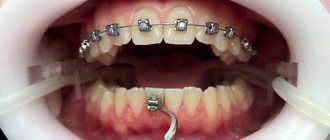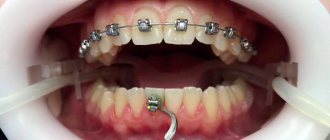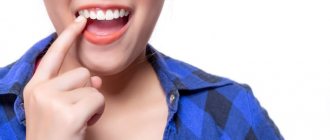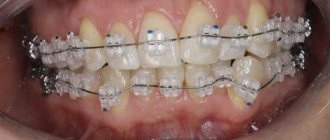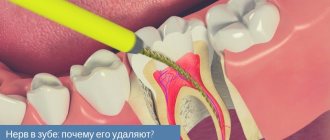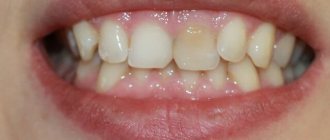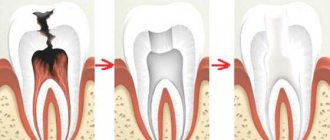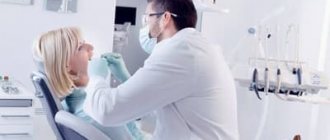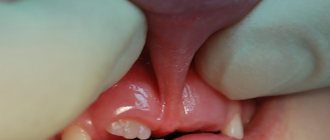Excursion into history | Ligature and self-ligating constructions | Biomechanics of tooth movement | System installation | Stages of treatment | Lingual and vestibular structures
Braces are locks fixed to the teeth with a groove and “wings”. The principle of operation of the system is the ability of the orthodontic arch to return to its original position. The straightening archwire puts pressure on the braces, causing the teeth to move. Fixed retainers and aligners stabilize the results obtained at the final stage of treatment.
The material was verified by Anna Rimkevich, senior product manager at Ormco Russia.
The basis of bite correction is the mechanism of action of weak forces and the movement of teeth in accordance with the bends and shape of the arch. The metal arch has “shape memory”: it straightens, pulls the braces along with it and moves the teeth in the desired direction. The formation and destruction of bone tissue is part of the natural process of tooth movement. The principle of operation of braces allows you to achieve the goal of orthodontic treatment - to create the best balance of occlusion, facial aesthetics and dentition.
Damon Clear with orthodontic arch
Stage No. 1. Visit to the orthodontist
This is the doctor you should make an appointment with to find out if braces treatment is right for you.
During the consultation, the specialist assesses the position of the teeth and, if according to the indications, braces are suitable for the patient, he offers options for braces with the obligatory indication of the estimated time frame and cost of treatment.
Of course, the orthodontist will talk about preparation for treatment, answer all the patient’s questions and send him home to make a decision. If the patient does not need time to think, you can go straight to the second stage.
Excursion into history
At the beginning of the 20th century, the American doctor Edward Engle created the first prototype of the braces system and called it the Engle apparatus. Angle's apparatus consisted of an elastic stainless steel arc and ligature elements. The arc was tightly fixed in the tubes. The tubes were soldered to orthodontic rings placed on the first molars. Each tooth was tied to an arch curved in the shape of the dentition with a ligature wire.
Subsequently, the scientist significantly changed the original design and developed the edgewise technique. Orthodontic locks, edgewise, were a rectangular piece with a groove. An arc was inserted into the groove and the lock was locked with a pin. Subsequently, the design of braces was modified: orthodontic arches with a square and rectangular cross-section profile, with sharp and rounded edges, appeared.
Later, the edgewise technique was further modified by doctors. Thanks to the active development of orthodontics in the 20th century, the modern operating principle of braces was formed. Today, the doctor is offered various options for torque and angulation. Torque (or inclination) is the deviation of a tooth from its axis in the vestibulo-oral direction. Angulation is the deviation of the tooth in the mesio-distal direction. Taking into account torque and angulation allows, based on a specific clinical case, to individually select the optimal brace option for each tooth.
Stage No. 2. Diagnostics
Diagnostic measures usually take from half an hour to an hour and consist of the following:
- orthopantomogram - a panoramic image of both jaws;
- teleroentgenogram (TRG) - a photograph of the skull in frontal and lateral projection;
- photographing teeth, as well as the face in profile and full face;
- taking impressions of both jaws.
Based on the diagnostic results, the doctor draws up an individual treatment plan for braces and virtual simulation of the result. All information is entered into the outpatient card, and the patient is referred to doctors of related specialties.
What is the bite like?
Occlusion - the position of the upper and lower dentition in the position of central occlusion. All types of bite can be divided into physiological and pathological.
Physiological:
- Orthognathic is the “ideal” variant of the bite, which is characterized by tight contacts between the teeth and dentition, as well as overlapping of the lower dentition by 1/3 of the crown;
- Biprognathic - a bite in which the crowns of the teeth are directed towards the vestibule of the mouth;
- Progenic – a bite characterized by a slight protrusion of the lower jaw forward;
- Direct - a type of bite in which, in the position of central occlusion, the upper and lower dentition touch the cutting edges.
These types of occlusion are allowed as variants of the norm of mutual arrangement of the dentition, since they are not capable of leading to functional disorders of the dentoalveolar system.
Pathological:
- Mesial – a bite characterized by protrusion of the lower jaw forward;
- Distal - a bite in which the upper jaw is more massive than the lower jaw;
- Deep - a bite in which the upper teeth strongly overlap the lower ones;
- Crossbite - a bite in which individual teeth of the lower jaw overlap the upper teeth in a separate area;
- An open bite is a bite in which gaps are formed between the closed teeth.
Pathological types of occlusion cause functional disorders in the dental system, and also, in some cases, disrupt the aesthetics of a smile.
Only an experienced orthodontist can most accurately determine the type of bite and draw up a treatment plan. Request an appointment in Moscow with Irina Aleksandrovna Butorina. The specialist has many years of experience, as well as more than a thousand satisfied patients.
Stage No. 3. Preparing for treatment with braces
Patients who visit the dentist at least once a year and regularly undergo professional teeth cleaning usually do not need a preparatory stage. Teeth and gums need to be healthy, so other patients may need:
- treatment of caries by a dentist;
- treatment of gums by a periodontist;
- A visit to a dental surgeon is required in difficult cases, for example, to correct a tongue frenulum.
Professional teeth cleaning is always part of the preparation for treatment with braces.
Comparison of lingual and vestibular constructions
Based on their location in the dental cavity, they are divided into lingual and vestibular systems. The vestibular position on the outer side of the dentition is classic and is used in the vast majority of cases.
Vestibular Mini Diamond
Lingual appliances are installed by patients with the highest aesthetic requirements. Adaptation to internal systems is more difficult compared to vestibular structures. The principle of operation of lingual and vestibular braces is not fundamentally different: in both cases, the arch is straightened and exerts a force on the braces, leading to the movement of teeth. If there is excessive crowding, the use of a lingual system is not recommended. The duration of treatment on the lingual structure is slightly longer than on the vestibular one. The patient sometimes experiences additional discomfort due to the interaction of the tongue with the brace system.
lingual braces STb
Stage No. 4. Installation of bracket systems
Depending on the type of orthodontic structure, fixing the braces takes from 1 to 2 hours and does not cause pain to the patient. The only condition is to come to the doctor, preferably after eating heavily, otherwise the process will cause excessive salivation.
As the work progresses, the orthodontist explains all the manipulations and talks in detail about the rules of hygiene when wearing braces.
Teeth hurt after braces tightening
We hasten to reassure you: this is natural and normal, because the pressure increases, and some discomfort, as at the very beginning, after installing braces, is inevitable. However, you should immediately tell your doctor about severe pain - constant discomfort that does not go away the next day after the tightening cannot be felt. You don’t have to endure it if the wire of the braces interferes with you and you touch it with your gums or tongue.
Dentist advice:
Before the braces tightening procedure, it is better to think through your diet in advance for a day or two in advance - exclude food that needs to be chewed vigorously and leave something simpler, soft food (yogurt, cereal, puree);- It is better to eat and brush your teeth before the procedure - afterward, due to the sensitivity of the teeth, it will be more difficult;
- Talk to your doctor about what type of pain medication you can take if the pain bothers you. Important: do not take painkillers or anti-inflammatory drugs on an empty stomach;
- After meals, you can (and even should) use an antibacterial mouth rinse.
Stage No. 7. Installation of retainers
Retainers are a group of orthodontic devices that are placed after braces are removed to secure the result.
The shape of the retainer is selected individually, as well as the material - polymer or metal and the method of attachment - removable or non-removable. Retainers are installed after professional teeth cleaning. The process takes about 15 minutes.
The duration of the retention period is different for everyone, and can range from 8 months to 5-6 years. You can talk about reducing the length of time you wear a retainer after control visits to the orthodontist every six months.
The author of the article is an orthodontist, Olga Vladimirovna Chugunova.
Why do you need braces tightening?
Braces lift
- a mandatory stage in the treatment of malocclusion, and a regular procedure that must be carried out if you want to achieve results. It's all about the mechanism of braces: the bracket, which puts pressure on the teeth, forcing the dentition to take the correct shape, reduces the pressure over time, and it must be tightened so that the effectiveness of the treatment does not decrease.
How often are braces tightened?
- is an individual question.
As often as necessary to straighten teeth. On average, a patient comes for a facelift procedure once every 2-3 months
, as prescribed by an orthodontist. The exact timing depends on many factors: the type of braces installed, the condition of the patient’s teeth, and the overall speed of treatment.
We remember that the treatment with braces itself lasts about 3-4 years - which means you will have to visit the dentist quite often, this is necessary not only to control the treatment, but also for periodic examination of the teeth, because caries forms under braces in the same way as on regular ones teeth
Specifics of treatment with braces in adults
Adult patients should keep in mind that it is often necessary to remove teeth to achieve a high-quality result of orthodontic treatment. This does not mean that every patient needs it; removal is carried out only in cases where there is not enough space to restore the normal position of the teeth. Foreign orthodontists change the jaw size of adults using surgery. In Russia, orthognathic surgery is not yet particularly widespread due to the fact that our patients are extremely reluctant to agree to undergo operations. Let us repeat that this is just information about how it might be. In most cases, orthodontic treatment for adults is limited to simply installing braces.
What are the best “adult” braces according to reviews?
Most adult patients respond positively to lingual braces. They are fixed on the back surface of the teeth and are absolutely invisible to others. This type of braces has the lowest profile: the clasps of the systems are lower than all others, and therefore do not interfere with diction, do not irritate the mucous membranes, and do not scratch the tongue. Adults also often choose non-ligature ceramic braces - they are practically invisible, quite durable and cheaper than sapphire structures. When choosing a vestibular system that is fixed on the front surface of the teeth, it is worth considering that no matter what invisible material its clasps are made of, the orthodontic arch will always be noticeable. Therefore, you can safely choose classic metal braces. Ultimately, preference for a particular design comes down to its price.
Resilines fastening system
Fixing Resilines braces is another modern method practiced in dentistry. This is the most popular adhesive for attaching braces. Its adhesive properties are very soft and sticky, ideal for bonding any type of overbite correction. Using the composition it is possible to fix metal, sapphire and ceramic products. The adhesive quickly hardens under the influence of ultraviolet lamps. But until the braces are glued and the locks are installed, it remains soft. The metal arch can be installed immediately after attaching the locks.
Regardless of the chosen method, the orthodontist, first of all, needs to focus not on the method of fixation and type of brace system, but on the doctor’s expertise. With the right approach, any of the methods will be effective.
How to put braces on teeth: direct and indirect methods
The next step in working with patients is directly fixing the braces. They do this in one of two ways:
- direct - a classic option used in every dental clinic;
- indirect - a progressive method that is gaining popularity.
A video on installing braces traditionally introduces the direct fixation method:
Direct method of installing braces
The orthodontist glues braces to each tooth one by one, based on a panoramic photograph of the jaw and the calculations made. The work is jewelry, highly precise, requiring care and concentration.
Stages of fixing the bracket system in a direct way:
- Installing an expander into the patient's mouth so that the orthodontist can clearly see and have access to all teeth.
- Fixation of orthodontic rings to the outermost units - “sixes” or “sevens”. The rings will serve as reference points for the entire system.
- Additional cleaning and polishing of tooth enamel to remove the smallest plaque particles.
- Drying the teeth with an air jet and insulating the tongue with a special “plug”.
- Application of components of an adhesive system to the teeth and plates, which, under the influence of ultraviolet radiation, will ensure the strongest fixation of each bracket.
- Cementing the rings on the outer teeth and passing a metal wire through each clasp is activating the braces.
- Removing excess orthodontic arch wire with nippers.
- Freeing the oral cavity from the dilator and tongue-fixing device.
First of all, braces are placed on the upper jaw and only then on the lower jaw. For the convenience of the patient, appointments can be spaced out in time so that there is an opportunity to adapt to wearing braces.
Devices are rarely attached to only one jaw - these are rather exceptional situations than everyday practice.
Indirect method of fixing the bracket system
This algorithm differs from the previous one in that part of the work is carried out outside the patient’s mouth.
In a dental laboratory, a technician uses dental impressions to make a plaster model. On it, the doctor places the locks at precisely calculated points and connects them with a metal arc. Afterwards, the resulting system is transferred to a mouthguard and placed on the corrected dentition. This allows you to fix the entire structure at once - quickly and comfortably for the child.
Does it make sense to get braces as an adult?
Correcting a pathological bite or incorrect position of teeth is, of course, not a matter of life and death. Rather, it is a matter of regaining self-confidence. The “curvature” of teeth has little effect on communication; after all, we perceive a person holistically, and not solely the state of his bite. But, you see, an open wide smile of any person will make him more attractive in our eyes. And only people who are not embarrassed to show off their teeth smile like that. Plus, when we talk about bite, it's not just about beauty, it's also about functionality. Nature intended that when chewing, the load on the teeth should be distributed evenly - this is only possible with straight teeth and a healthy bite. If this is not the case, then over time a person develops problems with the dental system: pain appears, clicks when opening and closing the mouth, etc. Therefore, orthodontic treatment for adult patients is not only possible, but also necessary.
The most difficult period is the first 2–3 weeks
Correction of orthodontic defects is based on the use of natural processes occurring in the body. The first evidence of the beginning of correction is the so-called dissociation of the bite, when the dental ligaments and bone tissue are forced, under the influence of the orthodontic arch, to begin to work in a new way.
This process can become very unpleasant for an unprepared patient: during the first few days, the closing of the jaws completely disappears, muscles begin to ache, and constant aching pain in the teeth appears and increases. If you are not used to it, braces can rub your cheek, tongue or gums, and in some cases, gum inflammation can even occur.
In fact, such a shock state of the dental system serves as excellent confirmation that the process has begun. But there can be no talk of a visual effect in the first few weeks of treatment.
At what age does it make sense for adults to get braces?
In any case, there are no age restrictions. There are surmountable obstacles: the general condition of the teeth, periodontal and gum diseases, and possible common concomitant diseases. Absolute contraindications for installing braces for adults coincide with many other types of treatment: lack of teeth, tuberculosis, diabetes, a number of immune diseases, epilepsy, bone pathologies, blood diseases. If a person gets braces when he is over thirty, the treatment will be quite long, since tissue regeneration occurs more slowly due to age. Plus, skeletal growth has already been completed, and the position of the bones can be “corrected” only when they are still growing - in childhood and adolescence. However, dentists achieve excellent results with mature patients.
It is important to change the arc on time
At each stage of treatment you need to get a certain result. Once it is reached and the teeth have assumed their new position, the archwire no longer works. And if you often postpone doctor's appointments, each week of delay prolongs the entire treatment.
Wearing one archwire for too long does not harm your teeth, but it does not make sense.
Treatment by an orthodontist requires self-discipline. Be prepared to adjust your schedule around your doctor's appointments. And remember that all this is done for the sake of health and a beautiful smile. And this is the best incentive!
Braces care
You should pay close attention to your oral hygiene while wearing braces to avoid the risk of tooth decay or other complications. To care for your teeth and braces, use special devices: brushes, brushes, and irrigators to effectively remove pieces of food between the structural elements. Floss (special thread) is good for removing food debris between teeth. When using braces, you should also exclude from your diet some foods that have increased coloring properties. This way you will protect the elements from more frequent replacement. For example, ceramic braces have an increased tendency to pigmentation.
